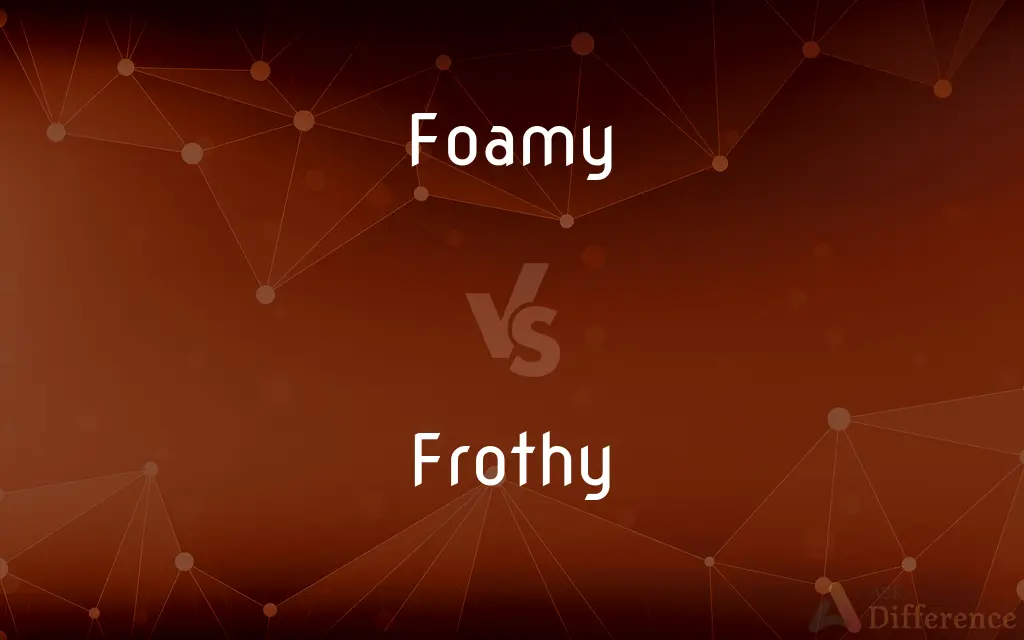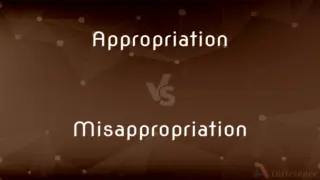Foamy vs. Frothy — What's the Difference?
Edited by Tayyaba Rehman — By Maham Liaqat — Updated on April 8, 2024
Foamy refers to a light, airy mass of bubbles, often seen in substances like soap, while frothy is more commonly associated with bubbles in liquids, especially drinks.

Difference Between Foamy and Frothy
Table of Contents
ADVERTISEMENT
Key Differences
Foamy describes a texture or quality where air or gas bubbles are trapped in a solid or liquid, creating a soft, spongy, or fluffy mass. This term is often used for substances like foam on a bath or shaving cream. Frothy, on the other hand, pertains to a lighter, more liquid-based form of bubbles, such as the froth on top of a cappuccino or beer, indicating a delicate, airy mixture often resulting from agitation or fermentation.
Foamy substances typically exhibit a certain stability or persistence, holding their bubbly structure for a period. In contrast, frothy mixtures may appear more ephemeral, with bubbles that are prone to quick dissipation or settling. For example, a foamy sponge holds air in its structure, while a frothy sea foam quickly loses its bubbles once the wave action ceases.
In terms of texture, foamy often implies a thicker, more substantial feel, where the presence of air bubbles is integral to the product's function, such as cushioning or insulation. Frothy textures, however, suggest a lighter, more delicate structure that adds a sensory pleasure to drinks or foods without significantly altering their density or purpose.
The application of these terms extends beyond the physical properties to their sensory and aesthetic appeal. Foamy is frequently used in beauty and hygiene products to convey a sense of luxurious lather and cleansing efficiency. Frothy, meanwhile, is commonly associated with culinary and beverage contexts, highlighting the appealing appearance and texture of food and drinks.
Despite their differences, both foamy and frothy describe the presence of bubbles in a medium, contributing to the texture, appearance, and sometimes the functionality of the substance. The choice between the two terms often depends on the context, the stability of the bubbles, and the texture they impart to the substance.
ADVERTISEMENT
Comparison Chart
Texture
Thick, spongy, or fluffy
Light, airy, delicate
Stability
Bubbles are more stable and persistent
Bubbles dissipate or settle quickly
Common Uses
Soaps, creams, and foams
Beverages like cappuccinos and beers
Implication
Indicates a substantial presence of air
Suggests a lighter, more ephemeral mixture
Sensory Appeal
Luxurious lather and cleansing efficiency
Adds sensory pleasure to drinks and foods
Compare with Definitions
Foamy
Characterized by a mass of small bubbles, creating a soft and spongy texture.
The foamy soap bubbles enveloped the bathtub.
Frothy
Describes bubbles formed through agitation or fermentation.
The beer poured into the glass with a frothy head.
Foamy
Indicates a texture that can retain its shape or form temporarily.
The foam on the cappuccino was surprisingly foamy and lasted longer.
Frothy
Indicates a delicate and ephemeral quality.
The frothy lace on her dress added a touch of elegance.
Foamy
Often associated with cleansing actions or chemical reactions.
The reaction between vinegar and baking soda created a foamy eruption.
Frothy
Can suggest a frivolous or unsubstantial nature in non-physical contexts.
The book was a frothy read, light and entertaining.
Foamy
Suggests a comforting or enveloping quality.
The foamy blanket of snow covered the landscape.
Frothy
Often used to describe beverages with a visually appealing top layer.
His favorite part of the cappuccino is the frothy milk on top.
Foamy
Referring to a dense, bubbly consistency in products.
He applied the foamy shaving cream to his face.
Frothy
Light and airy texture, especially in liquids.
The frothy waves crashed gently onto the shore.
Foamy
Of, consisting of, or resembling foam.
Frothy
Made of, covered with, or resembling froth; foamy.
Foamy
Covered with foam.
Frothy
Playfully frivolous in character or content
A frothy French farce.
Foamy
Full of foam.
He jumped overboard into the foamy waters of the Atlantic Ocean.
Frothy
Foamy or churned to the point of becoming infused with bubbles.
I like my milkshakes frothy, not flat like this!
Foamy
Covered with foam; frothy; spumy.
Behold how high the foamy billows ride!
Frothy
(figurative) lightweight; lacking depth or substance
Songs with frothy lyrics
A frothy argument
Foamy
Relating to or containing gas bubbles
Frothy
(business) Highly speculative; having high risk and high return.
Foamy
Emitting or filled with bubbles as from carbonation or fermentation;
Bubbling champagne
Foamy (or frothy) beer
Frothy
A serving of beer.
Foamy
Producing or covered with lathery sweat or saliva from exhaustion or disease;
The rabid animal's frothing mouth
Frothy
Full of foam or froth, or consisting of froth or light bubbles; spumous; foamy.
Foamy
Covered with or resembling small bubbles as from being agitated by beating or heating;
The bubbling candy mixture
A cup of foaming cocoa
Frothy milkshakes
Frothy waves
Spumy surf
Frothy
Not firm or solid; soft; unstable.
Frothy
Of the nature of froth; light; empty; unsubstantial; as, a frothy speaker or harangue.
Frothy
Emitting or filled with bubbles as from carbonation or fermentation;
Bubbling champagne
Foamy (or frothy) beer
Frothy
Relating to or containing gas bubbles
Common Curiosities
What makes a substance foamy?
A substance becomes foamy through the incorporation of air or gas bubbles, often resulting in a soft, spongy texture.
How do you create a frothy texture in food?
A frothy texture can be created by whisking or blending, introducing air into the liquid to form light, airy bubbles.
Can drinks be foamy rather than frothy?
Yes, some drinks, especially those designed to have a thicker texture, can be described as foamy, such as certain milkshakes or blended beverages.
Why is froth important in beverages?
Froth adds a sensory pleasure to beverages, enhancing the visual appeal and the texture of the drink.
What is the significance of froth in coffee drinks?
In coffee drinks, froth can enhance the flavor and mouthfeel, creating a luxurious experience for the drinker.
How is froth different from foam?
Froth is typically lighter and more ephemeral, often seen in liquids, while foam is thicker and can be more stable and persistent.
Is foamy always related to hygiene products?
While often associated with hygiene products, foamy can describe any substance with a dense, bubbly texture, including food items like whipped cream.
Are there any health concerns with foamy or frothy substances?
Generally, there are no health concerns with foamy or frothy substances unless they contain allergens or irritants specific to an individual.
Can a substance be both foamy and frothy?
Yes, in some cases, a substance can exhibit qualities of both, depending on its texture and the stability of the bubbles.
How do chefs and bartenders use foam and froth?
Chefs and bartenders use foam and froth to add texture, enhance the aesthetic appeal, and innovate with flavors in dishes and drinks.
Share Your Discovery

Previous Comparison
Contour vs. Profile
Next Comparison
Appropriation vs. MisappropriationAuthor Spotlight
Written by
Maham LiaqatEdited by
Tayyaba RehmanTayyaba Rehman is a distinguished writer, currently serving as a primary contributor to askdifference.com. As a researcher in semantics and etymology, Tayyaba's passion for the complexity of languages and their distinctions has found a perfect home on the platform. Tayyaba delves into the intricacies of language, distinguishing between commonly confused words and phrases, thereby providing clarity for readers worldwide.














































